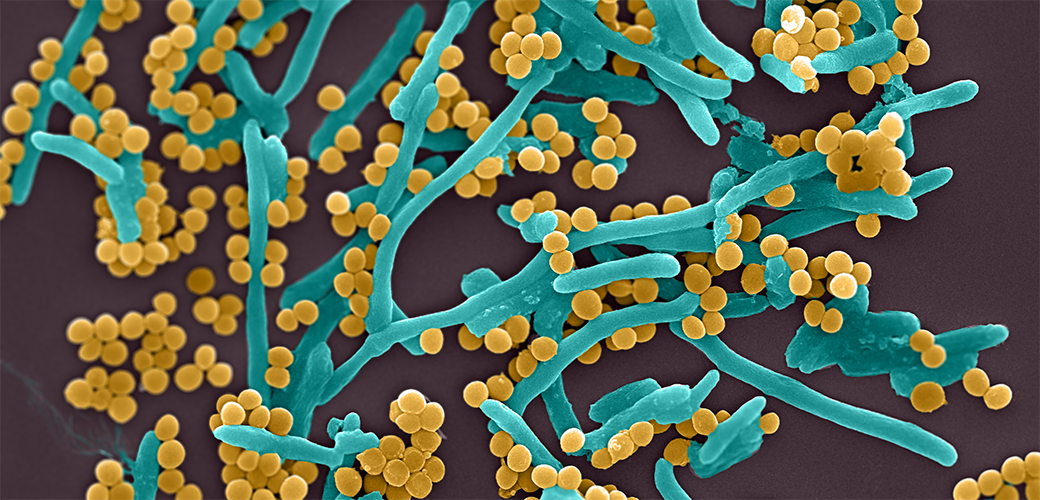Innovative materials to combat bacteria
A UNIGE team is developing new alloys with bactericidal properties to combat antibiotic-resistant germs.
 Three bacteria from the ESKAPE group: Staphylococcus aureus (yellow), Pseudomonas aeruginosa (short thick blue rods) and Escherichia coli (long blue rods). © UNIGE
Three bacteria from the ESKAPE group: Staphylococcus aureus (yellow), Pseudomonas aeruginosa (short thick blue rods) and Escherichia coli (long blue rods). © UNIGE
While crucial to biotechnology, bacteria can also cause severe disease, exacerbated by their increasing resistance to antibiotics. This duality between economic benefits and infectious risks underlines the importance of finding ways to control their development. A team at the University of Geneva (UNIGE) is currently developing a new generation of bactericidal alloys, with a wide range of industrial applications. They could be used to treat the contact surfaces responsible for their transmission. The project, which is supported by Innosuisse, will take 18 months to complete.
Resistance to antimicrobial drugs - such as antibiotics and antivirals - is a global public health issue. According to the World Health Organisation (WHO), it is currently responsible for 700,000 deaths a year worldwide. If no action is taken, the number of deaths will rise to 10 million a year by 2050, with dramatic consequences for public health and the economy.
To promote and guide research in this field, the WHO has published a list of pathogens that should be targeted as a matter of priority, because they are particularly threatening to human health. The list includes Staphylococcus aureus and E. coli bacteria, which are associated with the most common hospital-acquired infections, as well as salmonella. Contaminated contact surfaces (utensils, handles, stair railings) play a fundamental role in their transmission.
To address this problem, an interdisciplinary team from the Department of Quantum Matter Physics and the Microbiology Unit of the Faculty of Science at the UNIGE is developing new types of metal surfaces with bactericidal properties, targeted at the pathogens concerned. Supported by Innosuisse, the Swiss innovation promotion agency, the 18-month project aims to identify the most promising metal alloys and their potential applications.
Existing materials no longer fit the bill
‘‘We’ve known since ancient times that copper and silver, for example, have such properties. But germs are becoming increasingly resistant to them. What’s more, existing materials are thought to be toxic to humans. It is therefore crucial to design new bactericidal surfaces,’’ explains Jorge Cors, project leader in the Department of Quantum Matter Physics at the UNIGE Faculty of Science, and co-initiator of the project.
‘‘This is especially true for the pathogens identified as priorities,’’ continues Karl Perron, lecturer at the Microbiology Unit of the UNIGE Faculty of Science, and co-leader of the project. ‘‘These bacteria attach themselves easily to numerous metal surfaces, accumulating and forming a biofilm that secretes an adhesive material. This ‘glue’ protects their envelope and gives them greater resistance than other bacteria.’’
These bacterial biofilms can, for example, form in the microcavities in the marking of surgical instruments and implants. These microcavities are so small that they escape conventional disinfection processes. Bacteria can detach from them and infect the person being operated on or implanted. Their protective ‘‘glue’’ protects them from immune reactions and antibiotics.
New surfaces using nanotechnology
The new materials being developed by the UNIGE team consist mainly of titanium alloys with nanoscopic structures that are invisible to the naked eye. These so-called ‘‘nanostructured’’ surfaces are capable of damaging the cellular envelope of pathogens. ‘‘The challenge is to find the best combination of different metals and alloys to create revolutionary bactericidal surfaces,’’ says Jorge Cors.
Each new material is tested with priority bacteria. ‘‘We have already identified several alloys that work and that are very promising. The feasibility study is therefore complete. Now we need to assess the potential applications of these new materials, in particular by testing their toxicity on healthy human cells and the duration of their effect,’’ explains Karl Perron.
‘‘This is a great example of interdisciplinary research, exploiting techniques and knowledge from research into electronic materials. It responds to a public health problem by developing innovative alloys capable of attracting and trapping bacteria to destroy them in a targeted manner,’’ enthuses Christoph Renner, full professor in the Department of Quantum Matter Physics, head of the Scanning Probe Microscopy and Spectroscopy research group, and vice-dean of the Faculty of Science at the UNIGE.
These surfaces could be used to mark surgical instruments and implants, using metallurgical writing technology developed at the UNIGE’s Department of Quantum Matter Physics. It could be used to coat everyday contact surfaces to prevent the formation of bacterial biofilms, to treat pipes and filters in the food industry, which is directly concerned by the risk of infection. The scientists hope to compile a catalogue of possible bactericidal alloys - not all alloys are effective against the same bacteria - so that they can apply this research to targeted industrial applications.
